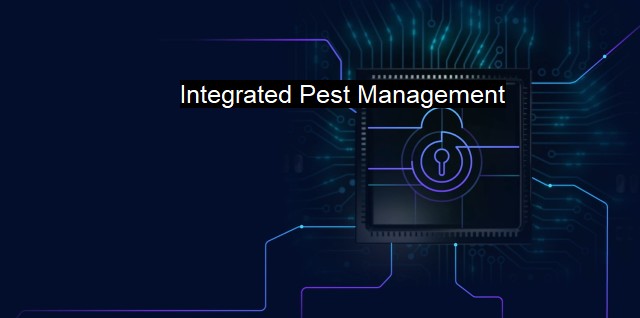What is Integrated Pest Management?
Integrated Pest Management for Cybersecurity: A Sustainable Approach to Managing Digital Threats
Integrated Pest Management (IPM) is an effective and environmentally sensitive method that's widely used in agriculture to control pest damage. This approach balances a combination of biological, cultural, physical, and chemical tools to minimize pest damage to crops. Peculiarly, this term has also found its way into the realm of cybersecurity. In the context of cyber defense, an equivalent strategy to Integrated Pest Management can be employed to deal with the constant onslaught of security threats.Like pests in the agricultural field that cause damage to crops, today's digital landscape also has 'pests'. These come in the form of malicious software such as viruses, spyware, ransomware, or hacking attempts by cyber-criminals who aim to infiltrate, exploit, and cause havoc to our information systems and data infrastructure. Each of these 'pests' pose a unique threat necessitating different counter-measures, symptomatic of an ever-evolving cybersecurity arena.
Drawing parallels with its agricultural counterpart, Integrated Pest Management in cybersecurity is not a single stand-alone technique, but rather a planned multi-pronged strategy designed to ensure the ongoing health of an organization's digital ecosystem. It combines various pathways by ticking several checkboxes. These include identification, avoidance, prevention, detection, containment, correction, and constant monitoring, cultivated into a proactive and exhaustive approach to security.
Identification comes first, including identifying all assets within one's digital ecosystem and assessing their inherent risks and vulnerabilities. This falls under 'cyber hygiene’, similar in spirit to tending and caring for crops to make them less susceptible to pests.
Next in the IPM approach is the avoidance strategy, focusing on managing human behavior to thwart common exploit pathways. This includes educating employees about phishing emails or risky web content. Regular patching and updating of software to close off known vulnerabilities is also crucial.
Detection and prevention firepower predominantly come from entities familiar to most -- Antivirus software. They're akin to the pesticides in agriculture, equipped to recognize established viruses and prevent them from causing concerns. Modern antivirus products have evolved to incorporate techniques that tackle a broader array of 'pests', including machine-learning features that help weed out malicious activity in real-time even from unknown threats.
One significant angle of the IPM approach is the containment and correction, which outlines measures against active system infections or a security breach. Together with the ability to limit damage and recover systems to a pre-infection state, this forms a critical part of the line of defence.
Lastly, there is a relentless cycle of constant monitoring and improvement to keep ahead in this cat and mouse game. Employing advanced intrusion detection systems that watch network traffic in real-time, or penetration testing that deliberately probe system vulnerabilities, these are systematic practices that acknowledge the dynamic nature of threats.
Integrated Pest Management in the context of cybersecurity and antivirus means a grittier, all-encompassing approach to dealing with ceaseless threats. Similar to how a diversified approach ensures crop health, a set of layered, comprehensive measures include user-awareness, constant system upgrades, effective antivirus use, and detection mechanisms, all held together by an overarching security strategy. This ensures a robust security posture that could defend against, contain and recover from not just the known threats of yesterday, but also the unfamiliar and advanced threats of tomorrow.

Integrated Pest Management FAQs
What is integrated pest management in the context of cybersecurity and antivirus?
Integrated pest management (IPM) is a holistic approach to managing pests that takes into account a variety of strategies, such as preventative measures, cultural controls, biological controls, and chemical controls. In cybersecurity and antivirus, IPM involves implementing multiple layers of protection to prevent, detect, and remove various types of malware and cyber threats.What are some key components of an integrated pest management approach in cybersecurity and antivirus?
Some key components of an IPM approach in cybersecurity and antivirus include: using firewalls and other network security measures to prevent unauthorized access; implementing antivirus software and other malware protection tools to detect and remove malicious software; regularly updating software and operating systems to address known vulnerabilities; and training employees to recognize and report potential security threats.What are some benefits of using integrated pest management in cybersecurity and antivirus?
Some benefits of using an IPM approach in cybersecurity and antivirus include: lower overall costs compared to relying solely on chemical controls (i.e., antivirus software); reduced risk of resistance to antivirus software and other security measures; greater flexibility in adapting to changing threats and vulnerabilities; and improved overall security posture.How can businesses and organizations implement integrated pest management in their cybersecurity and antivirus strategies?
Businesses and organizations can implement IPM in their cybersecurity and antivirus strategies by: conducting regular risk assessments to identify potential threats and vulnerabilities; developing and implementing policies and procedures to address these threats and vulnerabilities; investing in and deploying a variety of security tools and technologies; and regularly monitoring and reviewing their security measures to identify areas for improvement. Additionally, ongoing employee training and education can help ensure that everyone in the organization is aware of potential threats and knows how to respond appropriately.| | A | | | B | | | C | | | D | | | E | | | F | | | G | | | H | | | I | | | J | | | K | | | L | | | M | |
| | N | | | O | | | P | | | Q | | | R | | | S | | | T | | | U | | | V | | | W | | | X | | | Y | | | Z | |
| | 1 | | | 2 | | | 3 | | | 4 | | | 7 | | | 8 | | |||||||